This website is supported by its readers. If you click one of my links I may earn a commission. I am also a participant in the Amazon affiliates program and I will also earn a commission from qualified purchases.
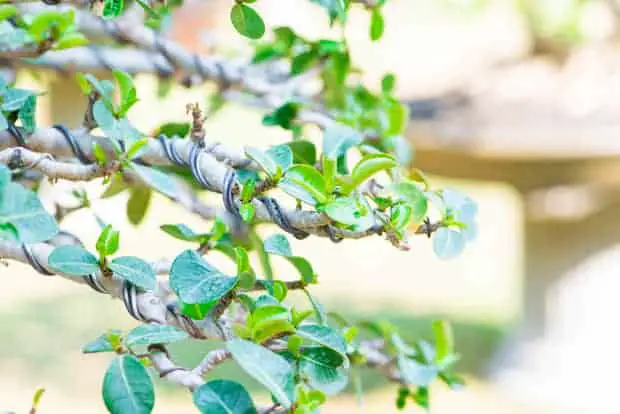
One of the most important aspects of keeping bonsai is training and shaping trees into a specific style and look. Easily the best way to achieve this is through wiring a bonsai. One question then I struggled with when I first started my bonsai journey, was how to shape a bonsai tree with wire?
To shape a bonsai tree with wire, use copper wire that is 1/3rd the size of a branch. Wrap around the branch at a 45-degree angle in the direction you would like it to move. Apply thin copper wire on secondary branches and move them into position. Remove copper wire after 4-6 weeks.
So what exactly is the best wire to use when shaping a bonsai tree? What’s the exact step-by-step process of wiring a bonsai tree? And are there any disadvantages when shaping a bonsai tree with wire? Keep reading to find out more!
Just a quick heads up, over the past three years of running Plantpaladin, hundreds of people have asked for product recommendations. As such, You can find my favorite indoor bonsai tree here (link takes you to Bonsaiboy), my favorite outdoor bonsai tree (link takes you to Bonsaiboy), or have a look at all the products I recommend here.
How to shape a bonsai tree with wire
Without a doubt, the biggest challenge I faced when I first started my journey keeping bonsai trees was how to shape a bonsai tree with wire.
Despite having a bunch of incredible styles in my head of how I wanted my bonsai tree to look, any amount of pruning or trimming would not be enough to shape my tree.
Instead, the wiring would be essential to create the more aesthetically pleasing trees I had in mind.
As such, I got in touch with a few bonsai-keeping experts, undertook a few courses, and visited my local botanical gardens to find out exactly how to shape a bonsai tree with wire.
Now after a few years of practice, I’ve succeeded at shaping a bonsai tree with wire and so I wanted to share the exact step by step process required so you can too:
- Ensure it’s the right time of year
- Only wire healthy trees
- Design your tree on paper first – image
- Ensure the trunk of your tree has been trained
- Clean up any excess foliage
- Select the right wiring
- Cut the wire to size
- Wrap and anchor the wire around the trunk of the tree
- Wire your bonsai
- Move your bonsai branches into position
- Apply a guy wire if needed
- Remove the wire after 4-6 weeks
- Give adequate aftercare
Let’s explore these in more detail:
Ensure it’s the right time of year
Whilst a lot of you will be keen to start the wiring process right away, an important and often forgotten question you need to ask yourself is if it is the right time of year.
You see the wiring process can and often will cause tiny cracks in the bark and cambium of your bonsai.
To maintain the health of your bonsai tree then, the wiring should only be done at the right time of year.
So what is the best time of year to wire a bonsai tree?
Wiring a bonsai tree should be undertaken as early in the spring as possible for most deciduous species. Wiring a bonsai should be done in the late summer for coniferous species as there will be less sap in the branches of the tree, making it easier to maneuver
This will ensure that the tree will have enough time not only to shape and grow into its new position but also to recover from any cracks that may have formed during the wiring process.
I would however definitely avoid any form of wiring during the winter unless you keep your bonsai in a temperature-controlled greenhouse.
This is because bonsai trees, regardless of species, will usually go dormant in the winter meaning your tree may not recover from the damage or cracks caused by the wiring process.
To help summarize I’ve created a table below around wiring in the different seasons:
|
Season |
Should you wire |
| Spring | Yes, deciduous tree species such as Chinese elm, oak, and maple will benefit from being wired as early in the spring as possible, giving them the best chance for healing and recovery. |
| Summer | Coniferous bonsai trees such as Pine or Juniper as well as and deciduous trees can both be wired at this time of year |
| Fall | Coniferous bonsai trees can be wired during the fall. Avoid wiring deciduous species |
| Winter | Only if you have a strict temperature-controlled greenhouse with plenty of UV light/sunlight. If not avoid it at all costs. |
Now it’s worth noting that the faster a tree grows, the faster it will recover from the process, but we will touch upon this later when we talk about the best bonsai tree species for wiring.
Only wire healthy trees
Another question you need to ask when working out how to shape a bonsai tree with wire is if your bonsai tree is healthy.
Bonsai trees, regardless of if you keep them indoors or outdoors are notorious for getting things such as pest infections such as aphids, scale, spider-mites caterpillars, and even mice or rats.
This can lead to a weakened tree and so you want to remove any infestation before work on the tree begins.
Wiring is a very intensive process for a tree and so I would not wire a bonsai under the following conditions:
- If your bonsai tree is less than 3 to 5 years old (if your bonsai has not reached maturity).
- Your bonsai tree has a fungal or mold infection.
- You have recently repotted your bonsai.
- Defoliated more than 80% of the leaves from your tree
- You have just undertaken alternative bonsai tree training and your bonsai is still recovering such as trunk splitting or trunk chopping.
If however, your tree is healthy and well recovered from any other type of training then your tree is good to go!
Come up with the design of your tree
So now you know that it’s the right time of year to wire your bonsai and your tree is in perfect condition you can’t start wiring right?
Not necessarily.
You see, I find one of the most important things to do is draw out a rough idea of the style and shape that you want your tree to look like.
Bonsai trees come in a wide variety of shapes and styles such as sumo, cascade, and informal upright to name a few.
As such, the amount of branch wiring required to achieve these looks will vary greatly depending on the style you opt for.
Drawing out what your tree looks like now, where you are going to put your wire, and how you want the branches to bend will give you something to aim for, making the process a lot easier.
Hopefully, the image below will help give an idea:

Ensure the trunk of your tree has been trained
Wiring is primarily used to move and shape the branches of a bonsai tree.
Whilst wiring can be used to thicken and develop the trunk of a bonsai, there are usually more effective methods to do so.
For example, if you want to achieve a thicker trunk, then growing out a sacrifice branch is usually the best option.
Want to add a bend in the trunk of your tree to create a cascade-style bonsai? Then removing a chunk of the trunk might be more beneficial.
Now, more importantly, the reason I am bringing up good bonsai trunk development at this stage is that if you have a weak bonsai tree trunk, or a bonsai tree trunk that does not resemble the style and shape of the tree you want, then you need to focus first on developing the trunk of the tree.
This is because a weak tree trunk will make for a weak anchor point for the wire to attach to.
On top of this, moving and manipulating a trunk can be a lot more difficult if you wire and train the branches before you train the trunk.
So to save yourself a lot of hassle, train your trunk first.
Can you wire the trunk of a bonsai tree?
The trunk of a bonsai tree can be wired to achieve a thick trunk or a tapered trunk. This process is often achieved better with trunk chopping and growing out sacrifice branches and so wiring is more effective when used on bonsai tree branches.
Clean up any excess foliage
Before you start wrapping wire around the branches of your bonsai, it’s important to clean up any excess leaves or branches that might get in the way of wiring.
Wiring is difficult at the best of times, let alone if you have loads of small leaves and secondary or tertiary branches in the way that makes the wiring process even more difficult.
As such, I’d use a sharp pair of shears or scissors and trim away any excess leaves and branches that will make the process of wiring more difficult.
Remove the branches and leaves the same way you will wire the tree-starting at the base of the tree and working your way outwards toward the branches.
Avoid removing too many branches or leaves, this process is only about removing any excess that needs to be removed, not removing all the branches or defoliating the entire tree.

Select the right wiring
Next up, you must find the right wire to use when shaping your bonsai tree.
Now while you might think any old wire can work, the truth is that there are loads of different varieties ranging from copper, aluminum, and plastic, all of which have different properties.
What is the best wire for wiring bonsai?
The best wire to wire a bonsai tree will be anodized aluminum wire for easy-to-move deciduous trees such as elms, and annealed copper wire for outdoor coniferous trees such as pine or junipers.
Copper wire is typically better at moving trees that are stronger, have thick branches, and need more force in moving branches into position.
The downside however to copper wire is that it can leave more indentation and marks on your tree so should only be used on these stronger trees.
Aluminum wire is better for smaller-sized bonsai trees that have thinner branches. The aluminum wire then is more beginner-friendly.
Aluminum wire however is weaker and tends to break during the wiring process and so should only be used on smaller trees that don’t require as much movement in the branches.
To help explain more about these differences, I’ve created a table below:
| Type of wire | Use case |
| Aluminum |
|
| Copper |
|
What wire should be avoided when wiring a bonsai?
Wire such as telephone wire, cables, steel wire, and wire made of alternative metals to copper or aluminum should not be used when wiring a bonsai. This can potentially damage and leave an excess indentation in your trees.
To find out more about how to wire a bonsai tree without wires I’d recommend reading my blog post here.
What size wire do you need when wiring a bonsai?
Bonsai tree wire should typically be 1/3rd the thickness of the branch that you are looking to wire. As such, multiple combinations of wire of different thicknesses are often used on bonsai trees. The most common wire sizes are 1mm, 1.5mm, 2mm, and 2.5mm thickness.
Bonsai tree wire should also be long enough to wrap around multiple branches – as such I would recommend using a wire that is about 1/3rd bigger than the length than the amount you require. Remember this wire will also need to wrap around the trunk too which is why having a little extra always works better.

You can always trim his back if there is too much excess.
My overall recommendation then would be to ensure you always go thicker than you might have anticipated. The whole aim is to move the branch and so it is always better to overestimate than underestimate the thickness required.
How to test if your wire is right for your tree?
To test that your wire is strong enough to be used on a specific bonsai branch, push about 2-3cm of the wire against the branch you’ll wrap it around. If the branch pushes back against the wire easily then a stronger wire is needed. If however, the wire can hold the branch in the palace it should be strong enough.

Just keep in mind that even if your wire is not strong enough, you can always use smaller secondary wires to hold the branch into position.

Cut your wire to size
Now you know what wire you will need for your tree then the next step is to simply cut this to size.
Start by measuring the length of the branch that you will wire and the rough length of the trunk.
Then add about 30% to this.
This will be the length of wire you need.
Then simply use a sharp pair of scissors and cut the wire to size.
An alternative method would be to unfurl the wire as you wire each branch from the wire roll, however, I find that this method can be a little more complex.

Wrap and anchor the wire around the trunk of the tree
The next step is to wrap the wire around the trunk of the tree.
Aim to do this at a 45-degree angle starting from the base of the trunk as you work your way up to the first branches that you will wire.
This will typically wrap around once on small-sized bonsai trees and twice on large-sized bonsai trees.
The reason you will be wrapping the trunk like this is to create an anchor point for the rest of the wire when we start to wrap the wire around the branches of our bonsai.
This will make it a lot easier to move the branches into place later on.
It’s important then to ensure that the wire is as tight and closely wrapped around the trunk as possible.
Now if you are wiring branches that are higher up then you will want to anchor this against the branch or trunk that is higher up – you won’t need to anchor this wire in the ground.

What if I have a weak trunk?
Now if you have a smaller trunk or a weak tree, you can still create the anchor point.
All you need to do is place the bottom 4 to 5cm of the wire in the topsoil of your plant pot.
You can also anchor this wire in place by tying this to the holes in the base of your bonsai drainage pot for extra anchoring.
Wire your bonsai
Now you have anchored your wire to the tree trunk we can (finally) start the process of how to shape a bonsai tree with wire.
There are two main methods to branch wiring:
- Single wiring
- Double wiring
Double wiring vs single wiring
Using double wiring works best on the larger thicker branches of your tree, the branches of your tree that are close together, or the branches of your tree you can’t single wire.
It is called double wiring because instead of wiring one branch with one piece of wire you will be wiring two branches, located near each other with the same piece of wire.
Single wiring is the process of wiring a single bonai tree branch.
This will be the most common method of wiring you will use on your tree.
Single wiring is also effective for smaller thinner secondary or tertiary branches.
How to single wire bonsai branches?
To single wire your bonsai wrap the wire from the trunk to the tip of the branch.

This wire should be tight against the branch of the tree.
This should be undertaken at a 45 degree angle.
Aim to wrap the wire on the place you would like the pressure to be applied.
You will then repeat this process for the other branches on the tree that you need to single wire.

As well as any secondary and tertiary branches which will also need to be single wired.
For these smaller sized branches, you will need to do is use thinner sized wire – aim for something that is 1/3rd the size of the branch.
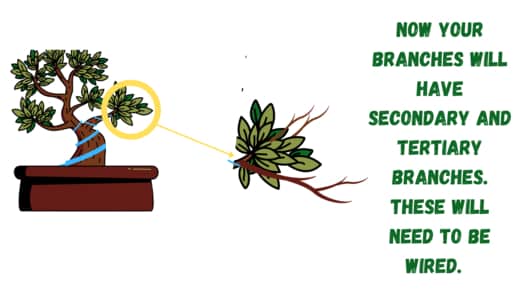
Ensure that you do not cross over any other wires in a cross shape as this can cause damage to the tree.
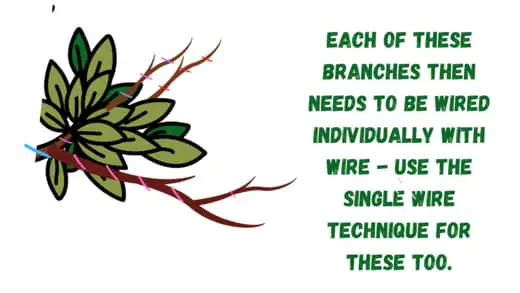
How to double wire bonsai branches
To double wire your branches, start by locating two branches nearby of the same thickness on your tree that you can wire together.
Start by wiring the middle part of the trunk as an anchor point – especially if you cannot plant the wire in the ground or around the lower trunk.
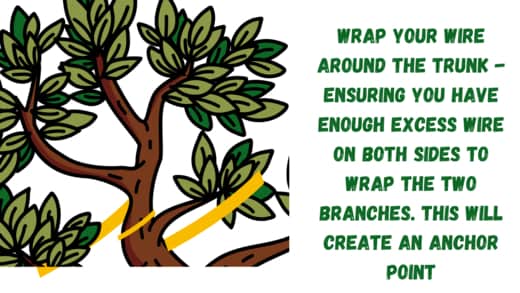
This should leave you with two excess parts of wire that you will wrap on the remaining branches.
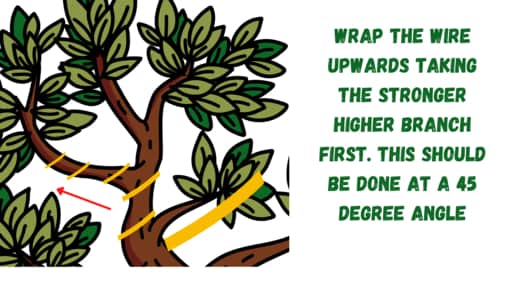
Then wrap the wire at a 45-degree angle, flush against the branches. You must apply the wire on the branch in the exact space where you would like the pressure to be applied.
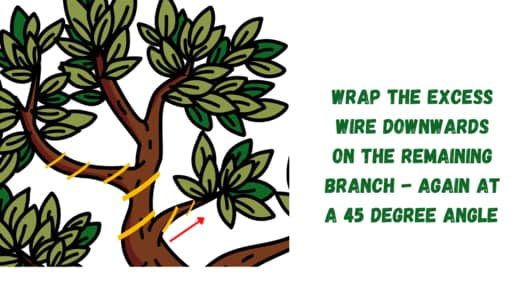
Move your bonsai branches into position
Now your bonsai tree branches will have been wrapped in their entirety in wire.
It’s time then to move the branches into the position you will have drawn out earlier.
Start by using your thumb and index finger and apply pressure to the branch.
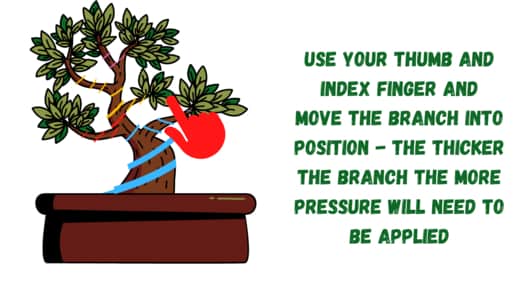
Most branches can either be moved clockwise, anticlockwise up and down, so decide on the direction you want to move the branch in and using a medium amount of pressure, move the tree.
Just keep in mind that the thicker the wire, the more the branch will bend.
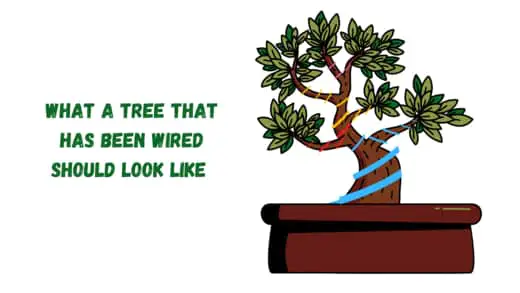
Apply a guy wire if needed
If you find that after moving your bonsai tree into a position that one of the branches is still too high then you might want to apply a guy wire.
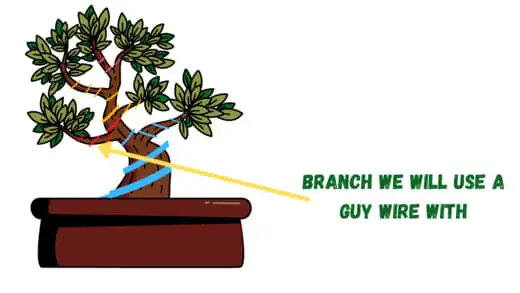
A guy wire is a wire that is anchored into the ground and used on branches to help push them lower.
To use a guy wire, apply some protective material on the branch that you will be using for the guy wire.
Then attach the guy wire to either exposed roots like nebari, or the base of your bonsai pot.
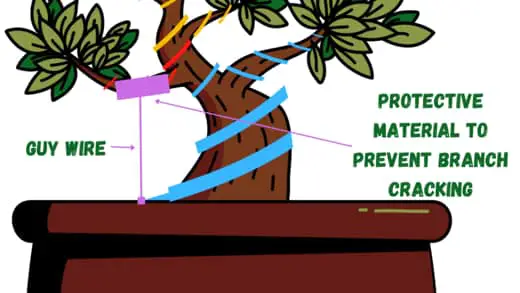
This will force the branch of the tree into position, using the full force of the tree.
Remove the wire after 4-6 weeks
After 4 to 6 weeks, the tree branches will have adapted to growing in the new positions and so the wire should be removed after 4 to 6 weeks.
Always cut the wire and avoid unfurling it from the tree which may cause even more damage.
To do this, use a sharp pair of scissors and make one clean cut on the wire until you can easily remove the wire from the tree.
Give adequate aftercare
Both during and after the wiring process, you must give adequate aftercare to the tree.
Ensuring then that you are watering regularly but not overwatering the tree, checking for signs of fungal or insect, or pest infestation, giving adequate sunlight, and keeping your tree in the best potting soil will all be vital to the success of your tree.
The wiring process is an intense one for the tree so you must pay close attention in the first few weeks to see how your tree is getting on with the wiring process.
So now you know the process of wiring a bonsai tree, let’s explore some FAQs that people have when it comes to how to shape a bonsai tree with wire:
What to avoid when wiring bonsai
The most common mistakes and main things that should be avoided when wiring a bonsai tree are:
- Having the wire wrapped around too loose – will prevent the branches from growing in their desired direction
- Not using thick enough wire – this again will prevent any movement in the tree branches
- Having multiple wires cross each other – this will cause significant damage to the tree
- Wiring an unhealthy or young tree – has the potential to kill the tree.
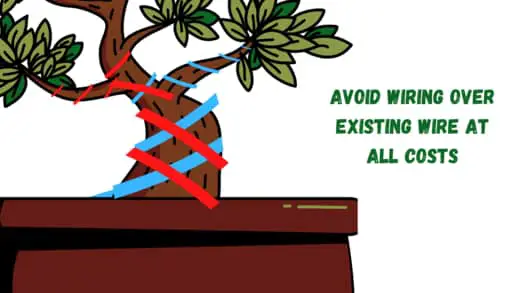
Do different bonsai species need to be wired differently?
When working out how to shape a bonsai tree with wire, it’s important to note that all bonsai trees will follow the same parameters. The only major differences will be the time of year and the length of time wires are left on.
Coniferous trees are better wired in late summer as possible when compared to deciduous species.
Faster growing bonsai trees such as Chinese Elm will also be able to heal much faster from the wiring process than slow-growing trees such as Jade meaning you can leave the wire on for a much quicker period.
To read up more on fast-growing bonsai species check out my post here, or check out the table below:
| Bonsai species | Growth type | Time to maturity | Average growth per year |
| Chinese Elm | Fast | 3 years | 12 to 36 inches |
| Juniper | Moderate | 4 years | 5 to 12 inches |
| Jade | Slow | 5 years | 2 to 5 inches |
| Maple | Fast | 3 years | 12 to 36 inches |
| Fukien Tea | Slow | 5 years | 2 to 5 inches |
| Ficus | Fast | 3 years | 12 to 36 inches |
| Wisteria | Slow | 5 years | 2 to 5 inches |
| Cotoneaster | Moderate | 4 years | 5 to 12 inches |
| Pine (most varieties) | Fast | 3 years | 12 to 36 inches |
| Azalea | Slow | 5 years | 2 to 5 inches |
How long should you leave the wire on a bonsai tree?
Wire should only be left on bonsai trees for 4-6 weeks. Fast-growing bonsai trees can need as little as 3 weeks of wiring compared to slow-growing species such as jade which will need wiring on for 2 to 3 months.
Does wiring a bonsai tree damage it?
Wiring a bonsai tree may cause temporary damage to the bark and cambium of a tree if the wire sussed is too thick for the branch. In most cases however, this damage will heal leaving no scars on the bonsai.
What is wiring a bonsai used for?
Wiring a bonsai tree is used to move and manipulate the branches of a bonsai tree to create a more visually appealing tree. It will also speed up the amount of time it can take to achieve a bonsai style, saving bonsai owners years in bonsai training.
Wiring is also used to add shape and structure to a bonsai tree.
What bonsai tree species work best for wiring?
Fast-growing bonsai species such as Chinese Elms work best for wiring due to the limited recovery time they require.
Succulent bonsai trees such as Jade bonsai, despite being a slow-growing species, also work well for wiring due to having a large amount of water in their branches making them easy to move in the wiring process.
Advantages of wiring bonsai
Wiring a bonsai tree has many advantages including:
- It can help add shape and structure to a tree.
- It speeds up the process of creating specific bonsai tree styles.
- Easy to master after a few attempts.
- Widely practiced.
Disadvantages of wiring bonsai
Wiring bonsai trees also has several disadvantages including:
- Can cause significant damage to trees if done incorrectly.
- Is not natural.
- Frowned on by some bonsai enthusiasts.
- The tree will be weakened during the wiring process.
What bonsai tree styles work best for wiring?
Bonsai tree styles that require a lot of bends such as cascade, semi-cascade, or informal upright benefit the most from the wiring. Bonsai tree styles that do not have a lot of movement or trunk development such as sumo or formal upright, will not benefit from wiring as much.
Alternatives to bonsai wiring
To style a bonsai tree without wires, simply replace the wire with a replacement that will generate the same effect. Bamboo, thread, yarn, and jute rope in particular work well for this.
What is the best wire to wire bonsai trees with?
As I’ve been wiring bonsai for a few years now I’ve been lucky enough or unlucky) to test out a bunch of different wires.
In my opinion, then the best aluminum wire available would be to grow a bonsai tree stores range which you can get on Amazon here.
Not only does this come with a wide variety of sizes in the collection, meaning you won’t have to worry about size but they also come in a bunch of different colors making them easy to camouflage
Now for those of you who require a copper wire for your bonsai trees then a fantastic option would be Wazakuras copper wire which you can also grab on Amazon here.
Thes wire was manufactured directly in Japan, comes with a money-back guarantee, and also comes in a wide variety of sizes.
Study on wiring bonsai
So hopefully the post today has helped answer the question how to shape a bonsai tree with wire.
Finally, I didn’t want to just give my opinion or wiring bonsai but wanted some expert advice.
As such I visited my local bonsai exhibition and asked one of the employees if wiring a bonsai tree is difficult:
“ Wiring a bonsai tree is not difficult, it only requires a little bit of patience. I’d start off small with trees that are more forgiving like elms and move on from there”
I also did a quick survey of 20 plant paladin readers asking them if the process of shaping a bonsai tree with wire was easy or difficult – here are the results:
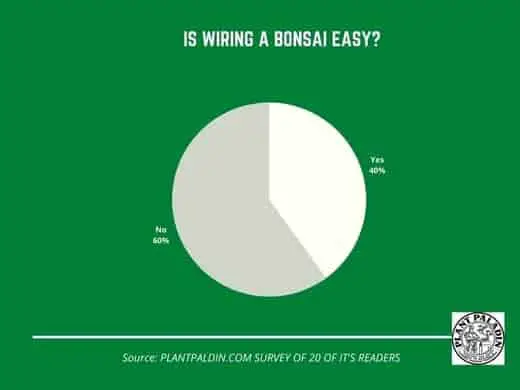
My top picks for the gear you will need!
So like I mentioned earlier, over the past three years of running PlantPaladin, hundreds of people have asked me for my recommendations on the best bonsai gear on the market.
Having spent thousands of dollars on bonsai items these past few years and tested at least 100 bonsai-specific products, I’ve listed my favorite products below – All of which I highly recommend and think you can get great value.
They can purchase directly by clicking the link to take them to Amazon.
Bonsai Tool Set: One of the significant challenges I’ve had is finding a toolset that was not only durable but didn’t break the bank. SOLIGT has recently developed a fantastic bonsai tool set that covers all the tools you need to trim, prune, and repot your trees. – You can grab it here.
Complete Bonsai Set: Many of you will want to grow your bonsai trees entirely from scratch, but finding the varicose seeds, pots, and other items in one place can be challenging. Leaves and Sole then have created a complete bonsai set that I’ve personally used that ticks all the boxes. You can grab it here.
Bonsai wire: The number of times I’ve run out of wire for my bonsai or purchased cheap bonsai wire that doesn’t do the job is embarrassing for me to admit. After a lot of trial and error, I found that using Hotop’s aluminum bonsai wire is one of the best options on the market. This can easily be used for both indoor and outdoor bonsai. You can grab it here.
This post was written by Fehed Nicass who has been passionate about bonsai for over 3 years
